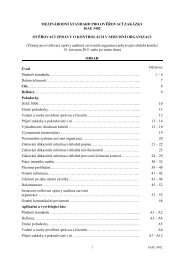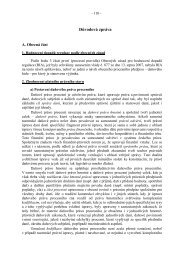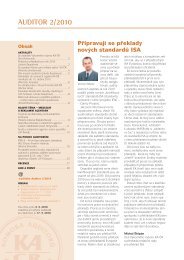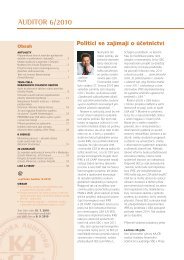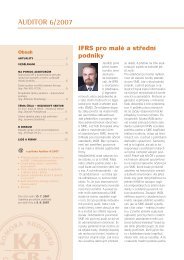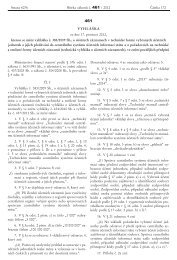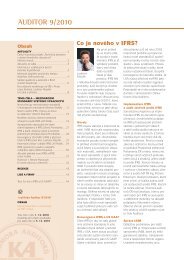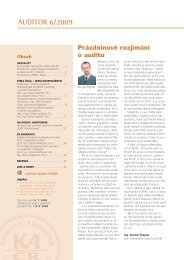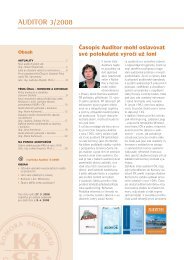Guide to Using International Standards on Auditing in - IFAC
Guide to Using International Standards on Auditing in - IFAC
Guide to Using International Standards on Auditing in - IFAC
You also want an ePaper? Increase the reach of your titles
YUMPU automatically turns print PDFs into web optimized ePapers that Google loves.
82<br />
<str<strong>on</strong>g>Guide</str<strong>on</strong>g> <str<strong>on</strong>g>to</str<strong>on</strong>g> <str<strong>on</strong>g>Us<strong>in</strong>g</str<strong>on</strong>g> <str<strong>on</strong>g>Internati<strong>on</strong>al</str<strong>on</strong>g> <str<strong>on</strong>g>Standards</str<strong>on</strong>g> <strong>on</strong> <strong>Audit<strong>in</strong>g</strong> <strong>in</strong> the Audits of Small- and Medium-Sized Entities Volume 1—Core C<strong>on</strong>cepts<br />
The difference between the two levels of risk assessment is illustrated <strong>in</strong> partial form <strong>in</strong> the exhibit below.<br />
Exhibit 6.4-2<br />
F<strong>in</strong>ancial Statement<br />
Level<br />
Pervasive risks that could<br />
apply <str<strong>on</strong>g>to</str<strong>on</strong>g> many asserti<strong>on</strong>s<br />
F<strong>in</strong>ancial Statements (Overall)<br />
Low<br />
Asserti<strong>on</strong> Level (partial) <br />
Account<br />
Balances<br />
Inven<str<strong>on</strong>g>to</str<strong>on</strong>g>ry<br />
Cash<br />
Payables<br />
Classes of<br />
Transacti<strong>on</strong>s<br />
Revenues<br />
Expenses<br />
Presentati<strong>on</strong><br />
& Disclosure<br />
Commitments<br />
Related<br />
Parties<br />
Relevant<br />
Asserti<strong>on</strong>s<br />
(assess risk for<br />
each asserti<strong>on</strong>)<br />
C<br />
E<br />
A<br />
V<br />
Low<br />
Mod<br />
Low<br />
High<br />
Note : This exhibit uses the comb<strong>in</strong>ed asserti<strong>on</strong>s described <strong>in</strong> Volume 1, Chapter 6.3.<br />
Asserti<strong>on</strong>s are used by the audi<str<strong>on</strong>g>to</str<strong>on</strong>g>r <str<strong>on</strong>g>to</str<strong>on</strong>g> form a basis for:<br />
• C<strong>on</strong>sider<strong>in</strong>g the different types of potential misstatements that may occur;<br />
• Assess<strong>in</strong>g the risks of material misstatement; and<br />
• Design<strong>in</strong>g further audit procedures that are resp<strong>on</strong>sive <str<strong>on</strong>g>to</str<strong>on</strong>g> the assessed risks.<br />
Exhibit 6.4-3<br />
Use of Asserti<strong>on</strong>s<br />
C<strong>on</strong>sider<strong>in</strong>g<br />
Types of Potential<br />
Misstatement<br />
Procedures<br />
This would <strong>in</strong>clude perform<strong>in</strong>g risk assessment procedures <str<strong>on</strong>g>to</str<strong>on</strong>g> identify possible risks of<br />
material misstatement. For example, the audi<str<strong>on</strong>g>to</str<strong>on</strong>g>r might ask questi<strong>on</strong>s such as the follow<strong>in</strong>g:<br />
• Does the asset exist? (Existence)<br />
• Does the entity own it? (Rights and obligati<strong>on</strong>s)<br />
• Are all the sales transacti<strong>on</strong>s properly recorded? (Completeness)<br />
• Has the <strong>in</strong>ven<str<strong>on</strong>g>to</str<strong>on</strong>g>ry balance been adjusted for slow-mov<strong>in</strong>g and obsolete items?<br />
(Valuati<strong>on</strong>)<br />
• Does the payable balance <strong>in</strong>clude all known liabilities at the period end?<br />
(Completeness)<br />
• Were transacti<strong>on</strong>s recorded <strong>in</strong> the right period? (Cu<str<strong>on</strong>g>to</str<strong>on</strong>g>ff)<br />
• Are amounts properly presented and disclosed <strong>in</strong> the f<strong>in</strong>ancial statements?<br />
(Accuracy)




